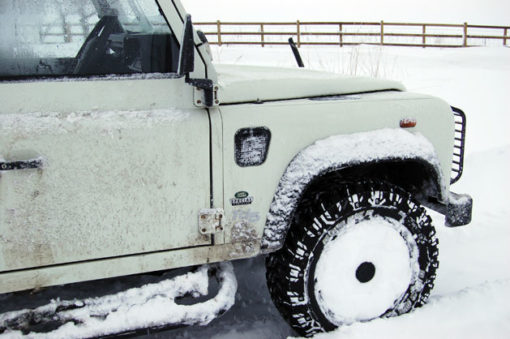
Fun Rover
April 27, 2021
Search
Popular Articles
8 Almost Useless Land Rover Mods
11th June 2014
Updated: What Makes a Defender Iconic?
29th November 2011
Larger vehicles place greater strain on the tyres that support them. Consequently, you’ll find off-road trucks and SUVs equipped with a class of tyre that you wouldn’t find on smaller cars. If you’re shopping for a new set of tyres, therefore, it’s worth being aware of the differences between 4x4 tyres and standard ones, and what they mean for the driving experience.

What makes 4x4 tyres different?
4x4 tyres tend to be softer than average, with deeper treads that are much more widely spaced. This helps the tyre to flex for maximum grip. You’ll find specialised off-road tyres, which are better suited to driving through mud, snow and sand. They don’t match quite as well for tarmac, however, and you will find that driving them on the road results in vastly reduced longevity.
You might find different types of off-road tyre specialised for different types of terrain. You can usually tell the difference by taking a look at the shape and extent of the tread.
Mud-terrain tyres
These come with a distinctly blocky tread pattern that’s built to distribute huge volumes of water away from the underside of the vehicle. This makes it almost impossible for them to slide out of control, even when the terrain is unforgiving. They also come with additional sidewall protection, which makes punctures less likely, and less damaging. However, for all of these advantages, tyres of this sort tend to make a great deal more noise on the road.
Highway-terrain tyres
At the other end of the spectrum are highway terrain tyres, which are more like a chunkier version of the tyres you might find on a smaller car. Since they’re smoother than mud-terrain tyres, they’ll wear much less quickly, and offer superior grip on roads. They’re also a lot less noisy, making them a good match for long journeys.
To get the best of both worlds, you might look to change tyres depending on the type of trip you’ll be taking. So, if you’re planning a long drive over the weekend, you might swap in a set of roadworthy tyres, if only to avoid the sound that the off-roaders make against the motorway surface.
The need to match tyres
In a front-wheel drive vehicle, the front two wheels are under much greater strain than the rear two, and consequently they’ll wear out twice as quickly. It’s common practice for motorists to move their rear tyres to the front once the front tyres have worn down.
In a four-wheel drive situation, things are different. In theory, all of the tyres will wear out at the same rate, since they’re all being driven by the same engine. As such, it’s important to match all of the tyres for consistent results.
About Us
FunRover is a place for Land Rover enthusiasts to gather as a community and discuss the best 4x4 vehicles ever produced. We're building a library of high quality resources & articles to help owners along in their Land Rover ownership.
Popular Posts
8 Almost Useless Land Rover Mods
11th June 2014
Updated: What Makes a Defender Iconic?
29th November 2011
How to Plastidip your Land Rover Defender
19th August 2014





